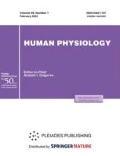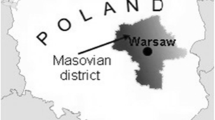Abstract
The content of 28 macro and trace elements (Al, Ag, Li, B, Ba, Bi, Ca, Cd, Co, Cr, Cu, Fe, Ga, In, K, Mg, Mn, Na, Ni, Mo, P, Zn, Se, Tl, Pb, Sr, S, and Si) in the hair of children and teenagers living in the European North of the Russian Federation (Arkhangelsk oblast) was studied by atomic emission spectrometry with inductively coupled argon plasma. Both a decrease and an increase in the content of certain elements were detected. The dynamics of the content of the above-mentioned elements in the hair of the same children in different years was traced. Significant individual variability of macro- and trace element status of northern children and certain gender dependence was revealed.
Similar content being viewed by others
References
Medvedev, V.I., Adaptatsiya cheloveka (Human Adaptation), St. Petersburg: Institut mozga cheloveka RAN, 2003.
Danishevskii, G.M., Patologiya cheloveka i profilaktika zabolevanii na Severe (Human Pathology and Prevention of Diseases in the North), Moscow: Meditsina, 1968.
Boiko, E.R., Nil’sen, O., and Boiko, S.G., Parameters of the body’s provision with riboflavin and activity of glutathione reductase in residents of the European North of Russia, Hum. Physiol., 2004, vol. 30, no. 2, p. 235.
Boiko, E.R. and Tkachev, A.V., The effect of the duration of daylight on human hormonal and biochemical indices in the North, Ross. Fiziol. Zh. im. I.M. Sechenova, 1995, vol. 81, no. 7, p. 86.
Krivoshchekov, S.G. and Okhotnikov, S.V., Proizvodstvennye migratsii i zdorov’e cheloveka na Severe (Production Migrations and Human Health in the North), Moscow, 2000.
Soroko, S.I., Burykh, E.A., Bekshaev, S.S., et al., Characteristics of the brain system activity and vegetative function formation in children under conditions of the European North (a problem study), Ross. Fiziol. Zh. im. I.M. Sechenova, 2006, vol. 92,issue 8, p. 905.
Suslikov, V.L., Geokhimicheskaya ekologiya boleznei: v 4 t. (Geochemical Ecology of Diseases, in 4 Vols.), Vol. 3: Atomovitozy (Atomovitoses), Moscow: Gelios ARV, 2002.
Kudrin, A.V. and Gromova, O.A., Mikroelementy v nevrologii (Trace Elements in Neurology), Moscow: GEOTAR-Media, 2006.
Skal’nyi, A.V., Khimicheskie elementy v fiziologii i ekologii cheloveka (Chemical Elements in the Physiology and Ecology), Moscow: Oniks 21 Vek, 2004.
Kozhin, A.A. and Vladimirskii, B.M., Microelementoses in human pathology of environmental etiology (literature review), Ekol. Chel., 2013, no. 9, p. 56.
Protasova, O.V., Maksimova, I.A., Cheprasov, V.Yu., and Nikiforov, A.M., Altered balance of macroelements and trace elements in blood serum, its ultrafiltrates, and hairs long after exposure to low doses of ionizing radiation, Biol. Bull. (Moscow), 2001, vol. 28, no. 4, p. 344.
Avtsyn, A.P., Zhavoronkov, A.A., Rish, M.A., and Strochkova, L.S., Mikroelementozy cheloveka: etiologiya, klassifikatsiya, organopatologiya (Human Microelementoses: Etiology, Classification, and Organic Pathology), Moscow: Meditsina, 1991.
Agadzhanyan, N.A., Skal’nyi, A.V., and Detkov, V.Yu., Elemental portrait of the man: the incidence, demography, and the problem of managing nation’s health, Ekol. Chel., 2013, no. 11, p. 3.
Miroshnikov, S.V., Notova, S.V., and Kvan, O.V., Characteristics of the elemental status in some nonspecific adaptive responses (increased activation and peractivation), Vestnik OGU, 2011, vol. 15, no. 134, p. 88.
Demidov, V.A., Lakarova, E.V., Skal’naya, M.G., and Skal’nyi, A.V., The elemental composition of the hair and the incidence of diseases among the adult population, Vestnik OGU, 2011, vol. 15, no. 134, p. 45.
Parshukova, O.I. and Boiko, E.R., The content of selenium in the human body in the conditions of the European North, in Tez. vseross. konf. s mezhdunarodnym uchastiem “Mediko-fiziologicheskie problemy ekologii cheloveka” (Proc. All-Russia Conf. with International Participation “Medico-Physiological Problems of Human Ecology”), Ul’yanovsk, 2007, p. 194.
Parshukova, O.I., Selenium and its functions in the population of the European North, Extended Abstract of Cand. Sci. (Biol.) Dissertation, Syktyvkar: IF KomiNTs UrO RAN, 2008.
Kubasov, R.V., Gorbachev, A.L., and Lakarova, E.V., Interdependence of the content of bioelements in blood and human hair, Vestnik OGU, 2011, vol. 15, no. 134, p. 75.
Subbioni, E., Vinoia, C., Pietra, R., et al., Trace elements reference values in tissues from inhabitants of European Community, J. Sci. Total Environ., 1992, no. 120, p. 49.
Sitdikov, F.G., Svyatova, N.V., and Egerev, E.S., Indicators of trace-element status of children living in rural areas, Bull. Exp. Biol. Med., 2011, vol. 152, no. 1, p. 12.
Svyatova, N.V., Egerev, E.S., and Sitdikov, F.G., Effect of cobalt on parameters of the cardiovascular system in elementary school children, Bull. Exp. Biol. Med., 2013, vol. 155, no. 3, p. 312.
Lysikov, Yu.A., The role and the physiological basis of the exchange of macro and trace elements in the human diet, Eksp. Klin. Gastroenterol., 2009, no. 12, p. 120.
Dobrodeeva, L.K. and Zhilina, L.P., Immunologicheskaya reaktivnost’, sostoyanie zdorov’ya naseleniya Arkhangel’skoi oblasti (Immunological Reactivity and State of Health of the Population of the Arkhangelsk Oblast), Yekaterinburg: UrO RAN, 2004.
Soroko, S.I., Bekshaev, S.S., and Rozhkov, V.P., EEG correlates of geno-phenotypical features of the brain development in children of the native and newcomers’ population of the Russian North-East, in Ross. Fiziol. Zh. im. I.M. Sechenova, 2012, vol. 98,issue 2, p. 3.
Zhestyanikov, A.L., Imbalance of some macro and trace elements as a risk factor for the cardiovascular system diseases in the North, Ekol. Chel., 2005, no. 9, p. 19.
Klimatskaya, L.G., Menyailo, A.V., Shevchenko, I.Yu., et al., Ecological and biological monitoring of the mineral status of organized students in Krasnoyarsk, Byul. SO RAMN, 2003, no. 3, p. 109.
Gudov, A.V., Bagryantsev, V.N., Kuznetsov, V.G., and Burago, A.I., Trace elements in the environment and hair of children, Ekol. Primor’ya, 2007, p. 123.
Trakhtenberg, I.M., Kniga o yadakh i otravleniyakh. Ocherki toksikologii (A Book on Poisons and Poisoning: Essays in Toxicology), Kiev: Naukova dumka, 2000.
Hartwig, A., Role of DNA repair inhibition in lead- and cadmium-induced genotoxicity: a review, Environ. Health Perspect., 1994, vol. 102, no. 3, p. 45.
Stohs, S.J. and Bagchi, D., Oxidative mechanisms in the toxicity of metal ions, Free Radic. Biol. Med., 1995, vol. 18, no. 2, p. 321.
Belushkina, N.N. and Severin, S.E., Molecular basis of apoptosis pathology, Arkh. Patol., 2001, no. 1, p. 51.
Oberto, A., Marks, N., Evans, H.L., and Guidotti, A., Lead (Pb2+) promotes apoptosis in newborn rat cerebellar neurons: pathological implications, J. Pharm. Exp. Therapeutics, 1996, vol. 279, no. 1, p. 435.
Soroko, S.I. and Trubachev, V.V., Neirofiziologicheskie i psikhofiziologicheskie osnovy adaptivnogo bioupravleniya (Neurophysiological and Physiological Bases of Adaptive Biocontrol), St. Petersburg: Politekhnikaservis, 2010.
Ho, L.Y., Ratnaike, R.N., and Zalewski, P.D., Involvement of intracellular labile zinc in suppression of DEVD-caspase activity in human neuroblastoma cells, Biochem. Biophys. Res. Commun., 2000, no. 268, p. 148.
Author information
Authors and Affiliations
Corresponding author
Additional information
Original Russian Text © S.I. Soroko, I.A. Maximova, O.V. Protasova, 2014, published in Fiziologiya Cheloveka, 2014, Vol. 40, No. 6, pp. 23–33.
Rights and permissions
About this article
Cite this article
Soroko, S.I., Maximova, I.A. & Protasova, O.V. Age and gender features of the content of macro and trace elements in the organisms of children from the European North. Hum Physiol 40, 603–612 (2014). https://doi.org/10.1134/S0362119714060115
Received:
Published:
Issue Date:
DOI: https://doi.org/10.1134/S0362119714060115



